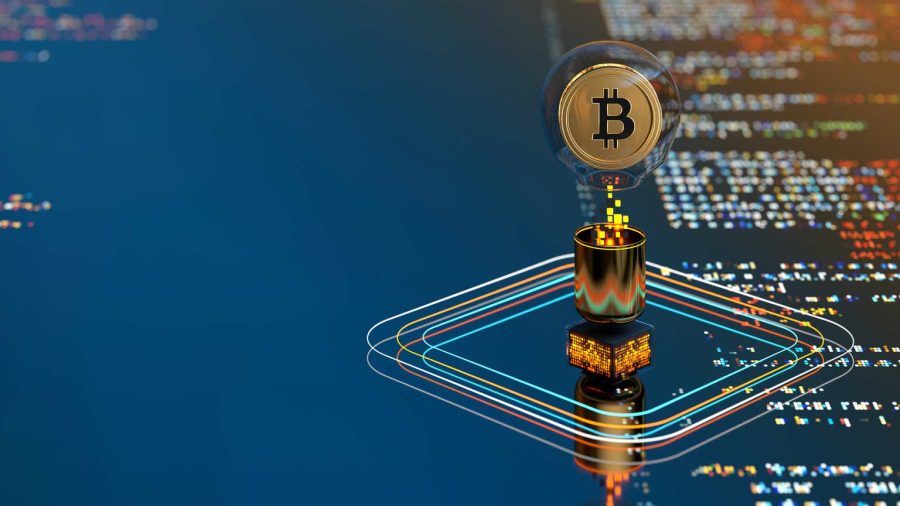Summary:
- Despite being a leading Bitcoin miner, I think MARA’s investment narrative is unconvincing due to unclear reasons for choosing the stock over holding Bitcoin directly.
- MARA has significantly diluted shareholders, with the number of shares outstanding increasing 44 times in the last four years, primarily to finance operations and stock-based compensation.
- It is unclear to me whether MARA aims to be a Bitcoin mining play or position itself as an alternative to holding Bitcoin, especially with its recent diversification strategy.
- MARA’s current market value is fair in my view, reflecting its current and projected Bitcoin holdings. However, the stock has shown variable performance relative to Bitcoin, adding uncertainty to its valuation.
- Due to the numerous variables at play, including shareholder dilution and unclear management direction, I rate MARA a HOLD. I think Investors are better off buying a Bitcoin ETF.
Olemedia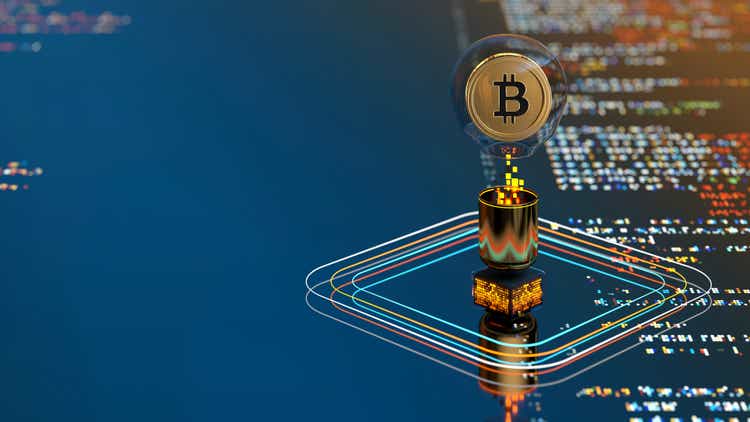
Thesis: Despite its leadership in Bitcoin Mining, I find MARA’s investment narrative unconvincing
I see Marathon Digital Holdings, Inc. (NASDAQ:MARA) as the best Bitcoin miner accessible to investors due to its leading hash rate and average Bitcoin production per day. In my view, the problem with MARA is not its leadership in Bitcoin mining, but rather the unclear narrative of why investing in this stock is preferable to simply holding Bitcoin.
MARA has recently announced a plan to buy $100 Million in Bitcoin to embrace a “HODL” strategy for Bitcoin, mentioning management’s belief in Bitcoin’s long-term potential. However, the company has been financing itself primarily via shareholder dilution, with total shares outstanding increasing by a factor of 44X in the last 4 years. The issuance of new shares in Q2 alone was worth over $800 Million, or eight times more than the announced one-off purchase of Bitcoin.
In this context, it is unclear to me whether management is trying to position the company as an alternative to holding Bitcoin or stick to being a Bitcoin mining play that relies on shareholders’ dilution to finance operations.
This investment thesis is further clouded by the fact that MARA recently started mining Kaspa, a relatively unknown cryptocurrency project, with a market capitalization below $4 Billion at the time of writing. I find this decision at odds with management’s recent claims about believing in Bitcoin’s long-term potential.
Judging from the historical performance of MARA’s stock against Bitcoin, I think the market is also uncertain about how to price this company.
Based merely on current and projected Bitcoin holdings, I think MARA is fairly valued – something I will cover in this article, along with MARA’s shareholders dilution and diversification strategy. However, because of an overall unclear investment narrative depending on too many variables, I rate the company a HOLD.
Investors seeking exposure to Bitcoin would be better off, in my view, buying a Bitcoin ETF, or investing in MicroStrategy Incorporated (MSTR) if they can stomach high volatility.
MARA: company profile of a leading Bitcoin miner
Marathon Digital Holdings, Inc. (MARA) is, in my view, the best Bitcoin miner currently available to investors. I base this assertion on two data points: the company’s average operational hash rate and the average number of Bitcoin MARA mines per day.
The Average Operational hash rate of MARA stands at 24 EH/s in Q2. This compares with 11.4 EH/s for Riot Platforms, Inc. (RIOT) and 20.4 EH/s for CleanSpark, Inc. (CLSK) – two other publicly listed, US-based Bitcoin miners.
For readers unfamiliar with the crypto world, the hash rate measures the processing power of a cryptocurrency network. It indicates how many calculations per second can be performed to validate transactions and secure the blockchain. In simple terms, a higher hash rate means a Bitcoin miner is better positioned to mine more Bitcoin from the blockchain.
The leading hash rate of MARA is reflected in the average number of Bitcoin mined per day. MARA produced an average of 22.9 BTC/Day in Q2, compared with 14.8 for CleanSpark and 9.27 for RIOT.
The above data points prove, in my view, how MARA has the best technical equipment and mining efficiency among publicly listed, US-based Bitcoin miners. While there might be privately owned Bitcoin miners outside of the US that have better hash rates – notably in Southeast Asia – these are not accessible to investors and are therefore outside the scope of this article.
While there is no doubt in my mind that Marathon Digital Holdings is an excellent choice for investors interested in Bitcoin miners, the real question is whether investing in this Bitcoin miner makes sense. Should investors rather opt for simply holding Bitcoin? This is the question I will try to answer in the following sections of this article.
MARA or Bitcoin? The market has many variables to consider.
In evaluating whether or not MARA represents an efficient – and potentially better – alternative to holding Bitcoin, I found numerous variables to be considered. I will go through them in this section of the article.
Before doing that, however, I want to start with a historical comparison between the company’s stock performance and that of Bitcoin. This comparison proves, in my view, how the market has been puzzled about how to price MARA for the last few years.
MARA vs. BTC performance, past 5 years (Seeking Alpha)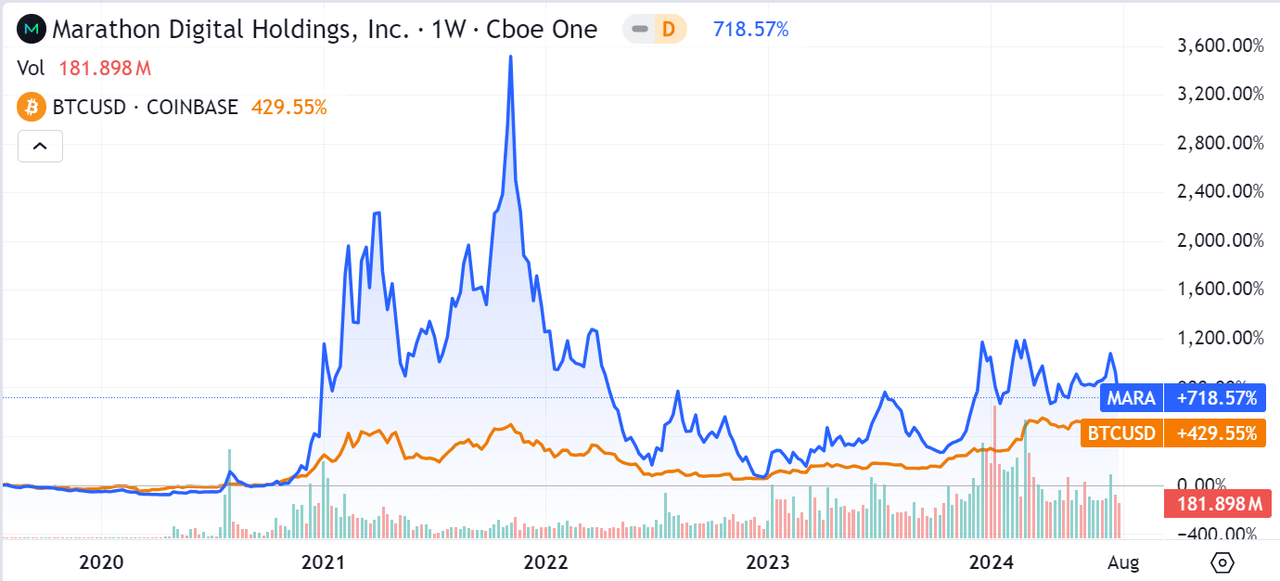
For the better part of the last 5 years, MARA overperformed Bitcoin. That overperformance mostly happened during the 2021 Bitcoin bull run, with MARA correcting back to Bitcoin’s performance during the following bear market.
MARA vs. BTC performance, past 6 years (Seeking Alpha)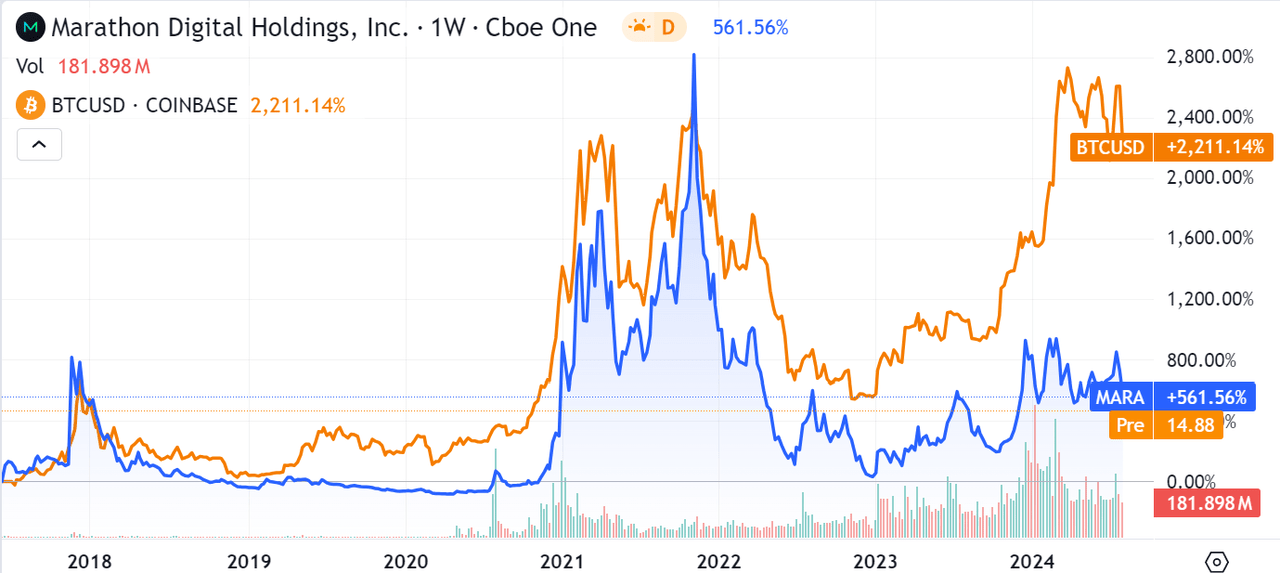
Interestingly in my view, the situation drastically reverses if we extend the time horizon to 6 years. Taking into consideration data from 2018, the previous bull run of Bitcoin, MARA has vastly underperformed Bitcoin itself. Most of Bitcoin’s overperformance happened through the crypto bear run of 2019 and 2020.
The reasons behind this apparent difficulty of the market in pricing MARA have to do, in my view, with the company variable and projected Bitcoin holdings, its heavy shareholders’ dilution, and its attempts at diversification. These are all elements I will cover in the next paragraphs, starting with its market valuation.
MARA’s valuation vs. its Bitcoin holdings: is it justified?
Marathon Digital Holdings has 18,536 Bitcoins as of July 3rd, 2024. At the time of writing, following a steep correction in BTC, the company has a market capitalization of just above $5 Billion, with its Bitcoin holdings worth just below $1 Billion.
I believe it is fair that MARA trades at a significant premium against its mere Bitcoin holdings. The company is a leading Bitcoin miner, and therefore I think the market should discount the future value of Bitcoin the company will mine over time.
Estimating the amount of Bitcoin that MARA will “extract” from the blockchain in the future is no straightforward task. This ultimately depends on the relative strength of MARA as a Bitcoin miner against all other Bitcoin miners on the blockchain. While MARA is currently a leader in the space, new entrants with better hash rates might come into play – especially if Bitcoin sees increasing adoption, including from governments and financial institutions.
I will attempt to calculate the worth of MARA’s future Bitcoin production by taking the latest post-halving numbers reported by the company and considering the effect of upcoming Bitcoin halvings on its operations. MARA produced 22.9 Bitcoin on average per day in Q2, following the Bitcoin halving in April. In the same period of 2023, MARA produced 32.2 Bitcoin on average per day, marking a 32% decrease.
Given the above data points, I am making the following assumptions to assess MARA’s future Bitcoin production and its fair market value at current Bitcoin prices:
-
MARA will produce roughly 20 Bitcoins per day until the next halving in April 2028.
-
After 2028, I assume MARA’s production will decrease by 40% for each subsequent halving event. This 40% figure is based on MARA’s historical performance and the company maintaining its leadership as a miner, which would offset the halving’s -50% impact on Bitcoin rewards.
-
For simplicity, I assume MARA’s relative strength against other miners will remain unchanged.
With the above assumptions, I expect MARA to produce ~27,000 Bitcoins until the 2028 halving (20 BTC per day, multiplied by 1349 days until mid-April 2028). I then expect the company to produce ~16,000, ~9700, ~ 5700, ~3500, and ~2100 Bitcoins for the following 5 five halvings (ending in 2048).
The total value of the roughly 64,000 Bitcoins I estimate MARA will produce is worth $3.3 Billion at current market prices. Adding the roughly $1 Billion worth of Bitcoin that MARA currently holds, as well as an additional $100 Million worth of Bitcoin that MARA plans to purchase, we have a total value of Bitcoin of $4.5 Billion – a figure that is close to MARA’s current market capitalization of $5 Billion.
In other words, the current market capitalization of MARA reflects the value of all the Bitcoins MARA holds, plans to hold, and will mine until 2048-and then some.
Given that MARA is a Bitcoin miner, I believe its market valuation should be justified exclusively by the Bitcoin it holds and is expected to produce. In this context, I think MARA’s valuation is currently fair, presenting a premium of around 10% against my calculation.
However, I think it’s worth noting that extrapolating figures until 2048 is a perilous task, as many things can change over such a long time span. In this regard, I believe investing in MARA presents an inherent risk, as it assumes the company will continue to be a leader in its industry for the foreseeable future.
MARA is diluting shareholders, and not necessarily for the right reasons
A key reason against holding MARA instead of Bitcoin concerns shareholders’ dilution. The company has very generous stock-based compensation and has historically relied on issuing new stock to sustain its business.
In the 3 months ended on June 30th, 2024, MARA issued roughly $80 Million in common stocks to cover for stock-based compensation. The company overall raised $834 Million from issuance of common stock during the same quarter. This figure compares with a Net Income of $137 Million.
These quarterly figures pale against the $100 Million the company has announced it plans to invest in Bitcoin for long-term holding. It is also the reason why, in my view, management’s strategy to diversify MARA as a Bitcoin “HODL” play -something I will cover in the next section – is not strong enough to change the fundamental investment narrative for this company.
I understand MARA does not want to sell its Bitcoin holdings to finance itself. At the same time, I think its heavy reliance on shareholders’ dilution – including for rewarding employees – is one of the strongest arguments against holding this company.
MARA Shares Outstanding, past 5 years (Companiesmarketcap.com)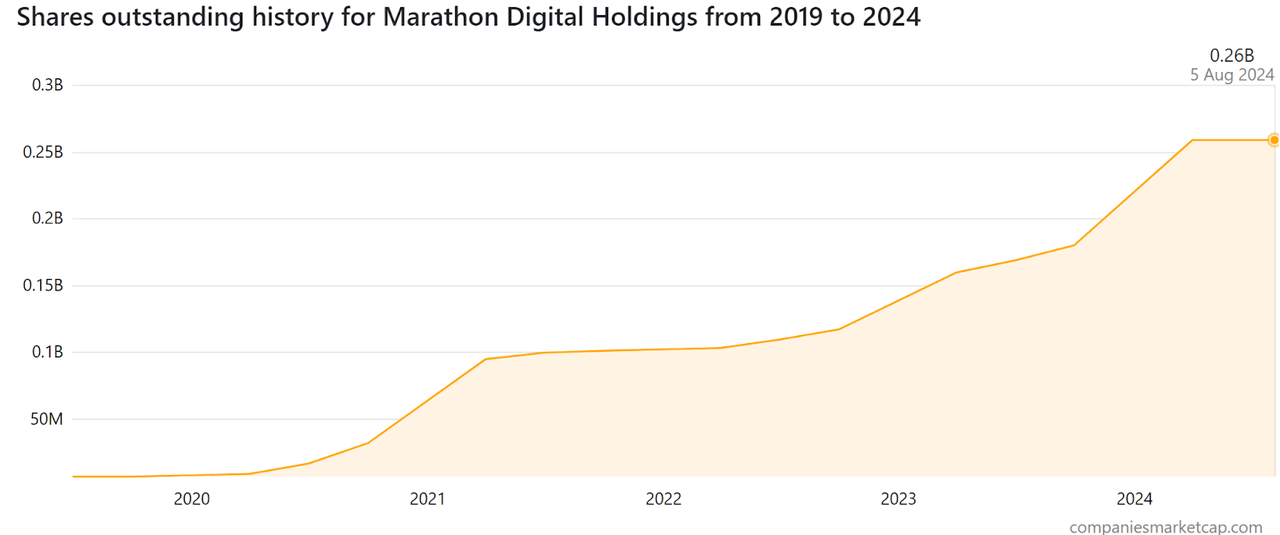
Perhaps the most convincing data point to illustrate just how reliant on dilution MARA is, is its history of shares outstanding. The company had only ~ 6.5 Million shares outstanding in 2020, and it currently has over 290 Million shares. This represents a 44X increase in the number of shares in less than five years.
“Diworsification” and a possible attempt at copying MicroStrategy’s playbook
A further element that I believe blurs the fundamental investment thesis for MARA, is management’s recently announced strategy of diversification.
The company is diversifying its core business in two ways. First, they have started to mine Kaspa, another cryptocurrency, in Q2 this year. Kaspa is a relatively recent cryptocurrency, introduced in 2022. In a nutshell, Kaspa proposes to be an alternative to Ethereum, based on a proof-of-work protocol.
The second way MARA is diversifying its core mining business is by committing to buying $100 Million in Bitcoin, in order to adopt a full “HODL” strategy. In management’s own words:
Adopting a full HODL strategy reflects our confidence in the long-term value of bitcoin […] We believe bitcoin is the world’s best treasury reserve asset and support the idea of sovereign wealth funds holding it. We encourage governments and corporations to all hold Bitcoin as a reserve asset.
I see two issues with this diversification strategy. First, the two legs of this strategy seem to be at odds with each other. If MARA is committed to Bitcoin and to “HODL”, why then mine a relatively unknown cryptocurrency? If MARA’s management truly was confident about the long-term value of Bitcoin, deploying more resources – and perhaps a better strategy – to purchase more Bitcoin over time would be more coherent with their thinking, in my opinion.
The second reason why I do not like this diversification strategy is that I do not see a $100 Million one-off purchase as radical enough of a commitment. I have already covered how this figure pales against the more than $800 Million that MARA raised by issuing common stocks in Q2 alone. I would have preferred management focus on increasing its Bitcoin per share and providing investors with a stronger case for holding MARA against Bitcoin. Overall, I think MARA would benefit from a clearer positioning as a Bitcoin thought leader.
In this regard, I see MARA’s diversification strategy as an attempt at copying MicroStrategy. MicroStrategy, which I covered in an article a few months ago, positions itself as a “Bitcoin development company.” The investment thesis for MSTR is fairly straightforward: the company aims to increase its BTC per share by strategically issuing new shares, cashing out the premium against its Bitcoin holdings.
This contrasts with an investment thesis for MARA that is clouded by continued shareholder dilution to sustain operations and an unclear strategic positioning on whether MARA should be considered a miner or an alternative to Bitcoin itself.
A remark about the secular performance of Gold Miners
Investors seeing Bitcoin as a long-term hold might be interested in a comparison against the performance of gold and gold mining companies.
While there are significant differences between the gold and Bitcoin mining industries, there are also similarities. Most notably in my view, economies of scale exist in both industries: both Bitcoin and gold miners are more efficient in “extracting” either asset, the larger and better equipped they are.
Gold Mining vs. Gold Mining stocks, 20 years comparison (Visualcapitalist)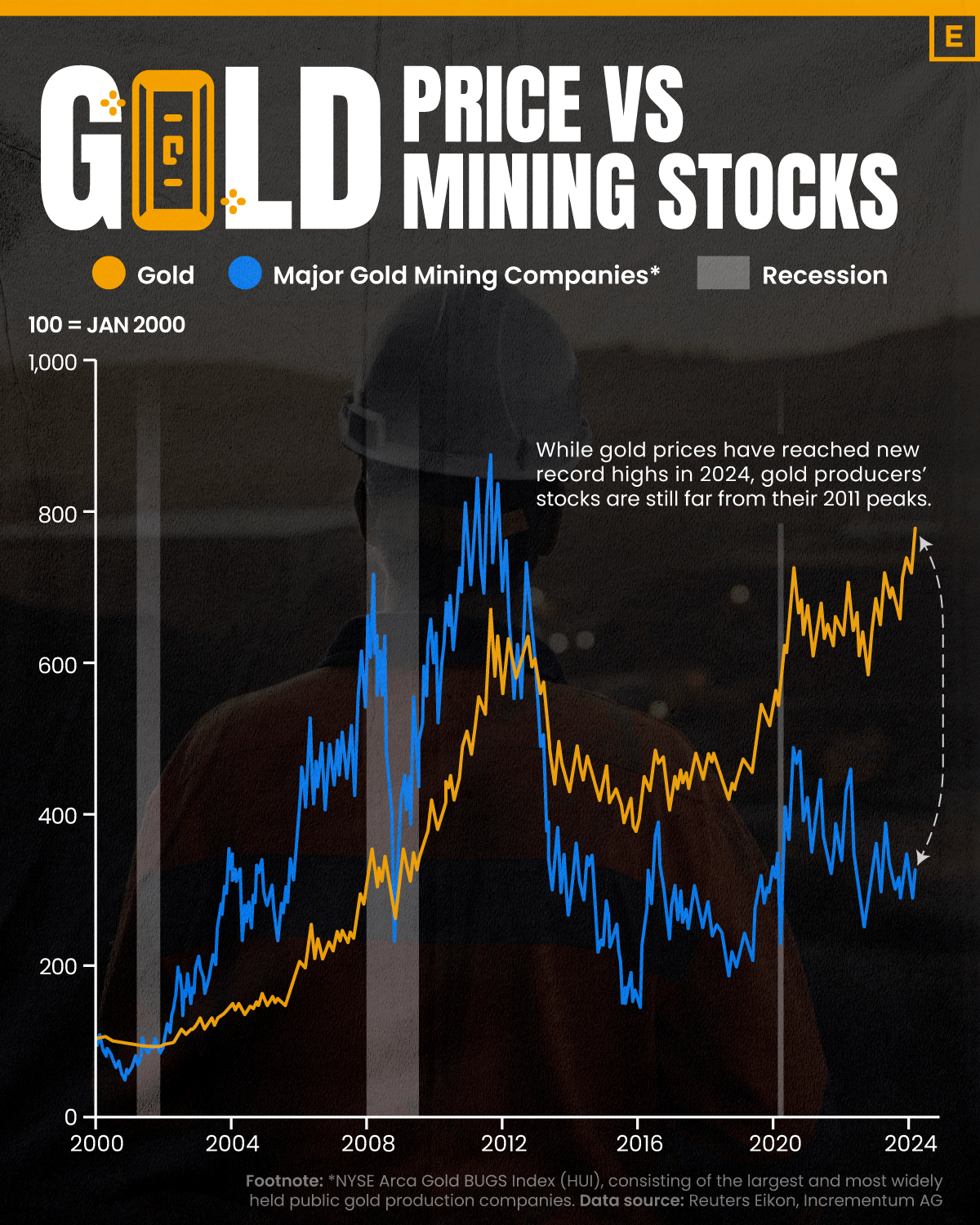
Historically, gold miners have overperformed gold since the early 2000s, up until the mid-2010s. Since then, the gap between gold and its miners has widened until it reached a record earlier this year.
I believe making parallels between gold and Bitcoin might be a bit too premature as Bitcoin still represents less than 10% of the market capitalization of gold.
Despite this, I think the comparison with gold miners might still be helpful to remind investors that even for a much more established asset class, miners can behave very erratically compared to their underlying asset. I think this is something investors should consider when evaluating whether to enter an investment in Bitcoin miners for the long term.
Risks to my thesis – market volatility and a high Bitcoin average mining cost
MARA remains a highly volatile stock, and investors interested in short-term bets or actively trading Bitcoin might benefit from trading MARA rather than Bitcoin itself, given its higher volatility.
Furthermore, the market might continue to assign a premium to MARA against its Bitcoin current and projected holdings. This might be especially true in the context of a Bitcoin bull market given how, historically, MARA has significantly outperformed Bitcoin in times of bull market.
This latter risk might also materialize if management decided to go all-in with a Bitcoin “HODL” strategy and lessen the reliance of the company on shareholder dilution. In other words, the main risk to my thesis is that the market might continue to “like” MARA more than Bitcoin, no matter if I find its investment narrative unconvincing.
Finally, there is also a risk that MARA might perform well in a sustained Bitcoin bear market. The average cost for mining Bitcoin at the moment is more than $75,000, above Bitcoin’s all-time high. In case the price of Bitcoin were to stay below its ATH for months or even years, smaller Bitcoin miners might go bankrupt and leave the blockchain. In this scenario, MARA would benefit by being one of the most resilient miners, given its dimensions and efficiencies. The less miners there are on the Bitcoin blockchain, the more rewards for each remaining miner, such as MARA.
While a prolonged Bitcoin bear market would hardly be good news for any crypto-related stock, I think this is a risk worth noting as it specifically concerns MARA being a leading Bitcoin miner.
Conclusion
In writing this article, I have not focused on whether or not entering a bet on MARA and/or Bitcoin makes sense at current price levels. Rather, I have focused on understanding whether investing in this leading Bitcoin miner could be more beneficial than investing directly in Bitcoin.
Investing in MARA means entering a historically highly shareholder-dilutive company, with a premium against its Bitcoin holdings (present and expected) that the market has valued very differently over time. Another issue, in my opinion, is the company’s relatively weak attempts at diversification, leaving some room for concern over management’s direction.
This, in my view, is in stark contrast to an investment in Bitcoin or MicroStrategy, which have a far clearer, albeit still risky, investment thesis.
Ultimately, I think there are too many variables at play when it comes to an investment thesis for MARA. For these reasons, I rate MARA a HOLD.
If you already have MARA in your portfolio, I see no reason for selling it, as the company might very well perform in line with or even better than Bitcoin based on historical data. However, I see no reason to recommend investors interested in Bitcoin to buy MARA instead of simply buying a Bitcoin ETF.
Analyst’s Disclosure: I/we have no stock, option or similar derivative position in any of the companies mentioned, and no plans to initiate any such positions within the next 72 hours. I wrote this article myself, and it expresses my own opinions. I am not receiving compensation for it (other than from Seeking Alpha). I have no business relationship with any company whose stock is mentioned in this article.
Seeking Alpha’s Disclosure: Past performance is no guarantee of future results. No recommendation or advice is being given as to whether any investment is suitable for a particular investor. Any views or opinions expressed above may not reflect those of Seeking Alpha as a whole. Seeking Alpha is not a licensed securities dealer, broker or US investment adviser or investment bank. Our analysts are third party authors that include both professional investors and individual investors who may not be licensed or certified by any institute or regulatory body.
